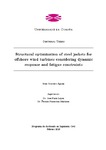Structural optimization of steel jackets for offshore wind turbines considering dynamic response and fatigue constraints

Use this link to cite
http://hdl.handle.net/2183/20695
Except where otherwise noted, this item's license is described as Atribución-NoComercial-SinDerivadas 3.0 España
Collections
- Teses de doutoramento [2227]
Metadata
Show full item recordTitle
Structural optimization of steel jackets for offshore wind turbines considering dynamic response and fatigue constraintsAuthor(s)
Directors
París, JoséNavarrina, F.
Date
2018Abstract
[Abstract]
It takes time for society to digest changes, but we are changing. We can not deny
climate change anymore and, as a species, we have come to realize there is an urgent
need to change our energy generation habits. They have changed indeed and, in the
last decades, renewable energies have clearly colored the picture of energy sources.
Particularly, wind energy is called to be one of the most valuable cards in the hand
of renewable energies in the near future. However, the current trend, and target of
this thesis, are not the typical wind turbines installed inland. In the last years, the
preferred location for the placement of wind farms has traveled, or we better say sailed
from land to the seas, seeking for higher efficiency and exploitation of wind’s potential.
Even though there are reasons to carry wind turbines offshore, the trip is neither easy
nor low-cost and implies the analysis and design of new substructures to bear the
weight of the turbines. Those substructures are called jackets.
This thesis defines a procedure of analysis of the dynamic behavior of offshore wind
turbines supported by jackets. Upon that analysis, a structural optimization problem
is defined and solved using mathematical and numerical optimization techniques. The
goal is to reduce the amount of material needed to manufacture the jackets and therefore
reduce the investment of offshore wind turbine structures and consequently the indirect
cost of energy production.
The structural model is based on a non-linear dynamic analysis of three dimensional
framed structures for fully coupled offshore wind turbines considering the rotation of
the blades. Special care is taken in the description of the environmental loading conditions.
Wind and wave actions and forces on the elements of the structure are thoroughly
modeled. One of the most decisive aspects in the design of offshore structures is fatigue
in steel elements arising from cyclic loads. In this thesis fatigue damage is assessed
in terms of S-N curves by means of the Palmgren-Miner rule and using the Rainflow
algorithm for counting stress cycles. Long-term fatigue damage in the joints of the jackets
is accurately estimated from the damage computed for short-term computational
simulations.
Since the analysis of the jackets is addressed in the time domain, the problem is faced
as a dynamic response optimization. Although there are a few methodologies to handle
time-dependent constraints, none is able to accomplish the task efficiently and still
retaining all the valuable information about the structural status. A novel methodology is introduced to efficiently deal with the time-dependent structural constraints imposed
to the dynamic response of the structure.
The optimization model is presented as a weight minimization of the steel jacket
under Ultimate Limit Stress, Fatigue Limit State and frequency constraints. Crosssections
of the tubular elements and bottom and top widths of the jacket are chosen as
design variables to perform a simultaneous shape and size optimization while preserving
the straight alignment of the legs. The optimization is addressed using Sequential
Linear Programming which requires a first order sensitivity analysis. The sensitivities
are obtained through Direct Differentiation and analytic derivatives except for the
fatigue damage constraint since it lacks analytic derivative. The sensitivity core of the
computational code constitutes an extremely expensive part in terms of CPU time and
storage.
The optimization methodology developed is applied to real jacket structures bearing
fully coupled rotating wind turbines. The optimization results show fair robustness of
the algorithm when facing different problems and substantial reductions in the weight
of the steel jackets are obtained while guarantying the fulfillment of the conditions imposed by the structural standards.
Keywords
Optimización de las estructuras
Centrales eólicas-Diseño y construcción
Materiales-Fatiga
Construcciones metálicas
Centrales eólicas-Diseño y construcción
Materiales-Fatiga
Construcciones metálicas
Rights
Atribución-NoComercial-SinDerivadas 3.0 España






